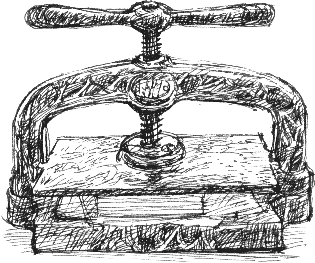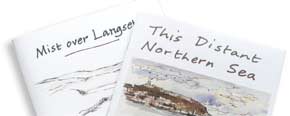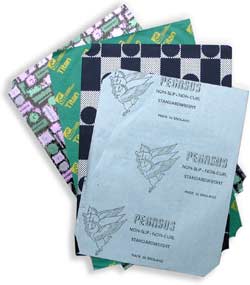|
 |

I've been busy printing copies of my new Sketchbooks
Sushi series. This is literally desktop publishing: the process
starts here at the computer, goes to the printer, then, after
collating, folding and stapling with a Bostitch booklet stapler
(saddle stapler), I trim with a fairly hefty hand-operated desktop
guillotine.
There's one final part of the process that takes
place on the studio floor: pressing the booklets so that they
don't have a tendency to spring open. I've tried putting them
in bundles under a great pile of the heaviest books from my shelves
but it doesn't have the same effect as the pressure you can get
with a press.
The Turning of the Screw
The screw still works so well that just flipping
one end of the handle will send it spinning through a full turn
but I wedge the press between my foot, or knee, and the wall so
that I can give it a last twist of compression using both hands.
Not surprisingly, it has made black marks on the studio floor,
so I've cut a piece of card for it to stand on.
|
Copy Press
 My
Dad brought this old copy press back from his Coal Board office in about
1968 or 69. It may then have been sitting around in some collliery office
for a hundred years. He thought that I might be able to use it for taking
lino prints, and I did do a few on it. He told me that when he started
working in an office, just before World War II, presses like this we still
used for their original purpose of copying business letters. Today you're
more likely to find them sold as antiques or used as a book press in a
bindery. My
Dad brought this old copy press back from his Coal Board office in about
1968 or 69. It may then have been sitting around in some collliery office
for a hundred years. He thought that I might be able to use it for taking
lino prints, and I did do a few on it. He told me that when he started
working in an office, just before World War II, presses like this we still
used for their original purpose of copying business letters. Today you're
more likely to find them sold as antiques or used as a book press in a
bindery.
The brass label records that it was manufactured (or perhaps just retailed)
by Patrick Ritchie, Oakfield, Edinburgh. There's no date
but the filigree of gold lines on black used to decorate it makes me think
it's Victorian rather than 20th century, although probably design was
pretty conservative over the years these presses were made (I can imagine
the Ritchie's salesman saying 'and our latest model features hand-painted
gold marbling, to suit the modern office').
It's about 10 inches (24 cm) high, and 15 inches (40 cm) X 8 inches (20
cm) at the base. It's just a fraction too small to take A4 paper. The
'daylight' - the space when fully open - is a little over 2.5 inches (almost
7cm).
Victorian Desktop Publishing
In an article published in The Office magazine Darryl
Rherr writes:
Desktop Publishing's first century began in 1856, when British chemist
William Perkins discovered the first synthetic dye, aniline purple.
This dye pointed the way to a wide range of new inks, including “copying
ink” used in the first practical method of reproducing business
documents.
An original written with copying ink was placed against a moistened
sheet of tissue, the two were pressed together in a massive iron press,
and a copy would appear on the tissue. Since the copy was backwards,
the tissue had to be held up to the light to be read. The copy press
became a fixture in every Victorian office. Today, they are sold in
antique shops as “book presses,” their true function long
forgotten.
Onion Skin
In a discussion on Books Arts Web D. Guffey
gives this account of the process:
. . . the purpose of this press was to make copies of documents prior
to the invention of carbon paper. A piece of onion skin type paper was
slightly dampened and placed on top of the page to be copied. After
sitting in the press the ink wicked up through the onion skin to make
a copy (as opposed to a mirror image).
I remember a brand of carbon paper (itself a fast-vanishing product)
that was marketed as 'Onion Skin', perhaps in a reference to the former
technology.
Carbon Copy
 Just
in case you're feeling a twinge of nostalgia for carbon paper
here are the varieties that have been sitting in a pile of unsorted papers
taken from the drawers of my old desk. They include 'Marathon' and 'Titan',
both produced by Columbia, and, going back to pre-A4 days, 'Pegasus'. Just
in case you're feeling a twinge of nostalgia for carbon paper
here are the varieties that have been sitting in a pile of unsorted papers
taken from the drawers of my old desk. They include 'Marathon' and 'Titan',
both produced by Columbia, and, going back to pre-A4 days, 'Pegasus'.
Titan, Marathon and Pegasus? Do you think the marketing department might
have been overstating the mythic grandeur of their carbon paper?
I remember books on 'how to be an author' which told you how to make
a copy of your manuscript to send to publishers using a freshw sheet of
carbon paper under the top copy in your typewriter and an old sheet of
carbon paper under that for a reference copy to keep yourself.
I'm not getting rid of my old Imperial typewriter but I felt it was time
to put these sheets in the bin. With my scanner and printer setup I can't
imagine any circumstances when I'd ever use carbon paper again. 
Related Links
Early Desktop Publishing
by Darryl Rherr at the Dead
Media Group
Book
Arts-L a discussion group at CoOL
- this 'project of the Preservation Department of Stanford University
Libraries, is a full text library of conservation information, covering
a wide spectrum of topics of interest to those involved with the conservation
of library, archives and museum materials.'
Richard Bell, richard@willowisland.co.uk |